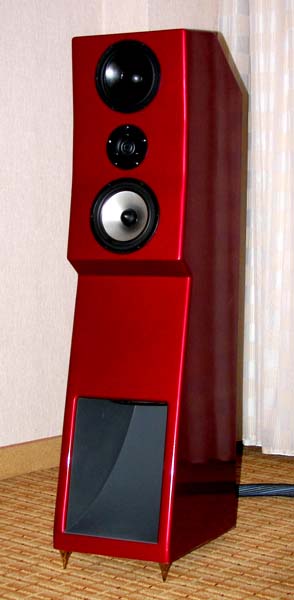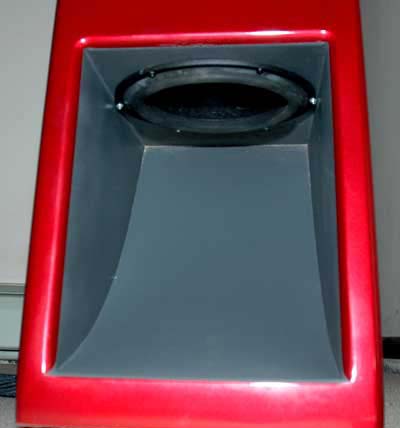NSR Sonic Research D3 Sonata Speaker
| NSR Sonic Research D3 Sonata Speaker |
| New Technology Gets Results! |
|
|
|
November 2008 |
 NSR Sonic Research is a promising new company that has developed, tested, and refined its novel design techniques over the last couple of decades. The company’s CEO and designer, John Tabernacki has used these techniques to develop speakers that image like no other, have articulate, extended bass, and yet, are relatively highly efficient. So far, NSR is offering two models in their “Concerto” series, the Concerto D1 Reference, the company’s flagship priced at about $33k, and the Concerto D3 Sonata, base priced at $5,995. As I am always on the lookout for more affordable alternatives to achieving near state-of-the-art performance, the D3 Sonata caught my eye and will be the focus of this review.
NSR Sonic Research is a promising new company that has developed, tested, and refined its novel design techniques over the last couple of decades. The company’s CEO and designer, John Tabernacki has used these techniques to develop speakers that image like no other, have articulate, extended bass, and yet, are relatively highly efficient. So far, NSR is offering two models in their “Concerto” series, the Concerto D1 Reference, the company’s flagship priced at about $33k, and the Concerto D3 Sonata, base priced at $5,995. As I am always on the lookout for more affordable alternatives to achieving near state-of-the-art performance, the D3 Sonata caught my eye and will be the focus of this review.
What if I told you that for only $5,995 there is a speaker that can provide an outstanding, crystal-clear soundstage, with precise imaging from bottom to top, with strong, detailed bass into the low 20Hz’s—are you interested? What if this speaker is of manageable weight and size (48” tall @ 100 lbs.), has a smallish footprint (11.5” x 16.5”), and a sensitivity of 93.7dB/watt? Does that grab your attention? It should!
Add to the above that the D3 is a uniquely attractive and modern looking speaker. By design, it has a sleek, sculpted appearance. Rather than using the typical MDF, which expands and contracts with temperature and humidity, NSR uses compressed high-density Melamite particle board, which is plastic coated. The D3s are presently offered in four standard colors Radiant Red Metallic, Pewter Grey Metallic, Pure Silver Metallic, and Brilliant Piano Black. A “Gold Stream” finish may also be available as a no-cost option by the time you read this. Custom colors are available at an additional cost of $500 for pearls or $250 for standard automotive finishes. The APLs (see “The technology,” below) are done in gray texture paint and can be finished in other colors such as black if requested at no additional charge. Extra heavy-duty metal cone feet are also provided and can be ordered in different finishes too.
Drivers and crossover:
The D3’s driver compliment consists of an Usher heavy-duty 8” woofer, which crosses to two 6” midrange drivers at 226Hz where the woofer is rolled off at 6dB per octave. One 6” driver has a synthetic-fiber treated cone, the other is an aluminum cone unit with a phase plug. The two 6” drivers cross to a 1” Vifa ring radiator tweeter at 3,200Hz using a 12dB per octave slope, based on proven Linkwitz Labs filter design. Since the 2nd order crossover inverts polarity, Tabernacki inverts the tweeter polarity to keep it in proper phase with the midrange drivers. Although the system is very efficient, the drivers are quite robust, thus allowing the to D3 handle high power without any distortion or driver break-up. I had them cranking with my NuForce Ref 9V2 SE amps in my large listening room.
The NSR D3 Sonata comes with a standard crossover containing Auric capacitors along with Erse Perfect Lay inductors and ceramic resistors. This is an excellent crossover and Tabernacki is proud of the fact that the individual components are hard-wired together in a smooth path and not merely soldered to a thin trace on a printed circuit board as is commonly done in countless other designs. Patented Cardas binding posts (for spade-lug connectors only) are the standard binding-post termination.
For $1,000 more, there is an optional reference crossover that employs the new MR series Clarity capacitors and Litz inductors with Vishay and Duelund resistors. Duelund capacitors may be substituted at no additional charge. Optional gold-plated Supra Boxcon connectors may be substituted for the Cardas speaker connectors if desired. The D3 Sonata also incorporates a Fostex L-pad to adjust the tweeter level for different rooms and different tastes.
My review samples are finished in the inconspicuous Pewter Grey Metallic and contain the Clarity-capped reference crossover and the gold-plated Supra Boxcon speaker posts, which handily accept spades, bare wire, or banana plugs. The retail cost of the D3 Sonatas as reviewed is $6,995.
The technology:
Aside from using some of the finest quality crossover parts available, Tabernacki has developed two novel technologies that enable the D3 to possess such high efficiency, bass virtuosity, and elite imagery.
 The first is his patented Acoustic Projection Lens (APL). Instead of employing a ported or bass reflex design, the APL the woofer in the D3 fires down into a curved acoustic panel that inverts the waveform and then focuses and redirects the bass frequencies much like a prism focuses and separates the different colors of the visible light spectrum. The panel is tuned by Tabernacki much like one would tune the wood body of a violin or guitar. It curves around so that the bass waves are directed forward, toward the listener.
The first is his patented Acoustic Projection Lens (APL). Instead of employing a ported or bass reflex design, the APL the woofer in the D3 fires down into a curved acoustic panel that inverts the waveform and then focuses and redirects the bass frequencies much like a prism focuses and separates the different colors of the visible light spectrum. The panel is tuned by Tabernacki much like one would tune the wood body of a violin or guitar. It curves around so that the bass waves are directed forward, toward the listener.
This method has the noteworthy effects of amplifying the bass acoustically and also rendering the bass frequencies more directional. So for possibly the first time, we reap the benefits of much more efficient and extended low bass, combined with full range imaging capability.
Audiophiles are always told that low bass is non-directional. Well, it may be with other speakers, but not with the NSR D1 or D3. That’s correct, you’ve read it right—the NSR speaker designs provide fantastic imaging not only in the midrange and highs, but in the low frequencies as well. Plus, once you move back 10 ft or more from the speakers, there is an incredibly wide and stable stereo image that stretches laterally from speaker to speaker and even beyond. This is definitely not one of those “head-in-the-vise” designs, which I’m sure you and your guests will appreciate.
The second technique that Tabernacki employs is to line his cabinets with NSR’s exclusive Acoustic-Comb non resonant panels! This approach eliminates all internal resonance and standing wave echoes allowing the drivers cones to react more positively to the input signal. It effectively creates an anechoic chamber within the speaker cabinet. NSR claims that no other speaker manufacturer has this technology. I can personally attest to its positive effects as you will see later in my listening impressions.
Breaking it in:
When Tabernacki sent me the D3s, he asserted that they would require 100 hours or more of break-in time.
I played the speakers many hours on most days over the first 3 weeks. It seemed that somewhere between 70 and 100 hours the speakers became somewhat less bright, and began sounding more natural—and they continued to smooth out and improve after that. My advice is to play them as much as you or your family can tolerate when you first get them. The D3s will take a considerable amount of time to burn in the electronic parts and begin sounding their best. They seemed brighter in the lower treble during break-in.
![]()
Don’t forget to bookmark us! (CTRL-SHFT-D)
Stereo Times Masthead
Publisher/Founder
Clement Perry
Editor
Dave Thomas
Senior Editors
Frank Alles, Mike Girardi, Key Kim, Russell Lichter, Terry London, Moreno Mitchell, Paul Szabady, Bill Wells, Mike Wright, Stephen Yan, and Rob Dockery
Current Contributors
David Abramson, Tim Barrall, Dave Allison, Ron Cook, Lewis Dardick, Dan Secula, Don Shaulis, Greg Simmons, Eric Teh, Greg Voth, Richard Willie, Ed Van Winkle, and Rob Dockery
Music Reviewers:
Carlos Sanchez, John Jonczyk, John Sprung and Russell Lichter
Site Management Clement Perry
Ad Designer: Martin Perry







Be the first to comment on: NSR Sonic Research D3 Sonata Speaker